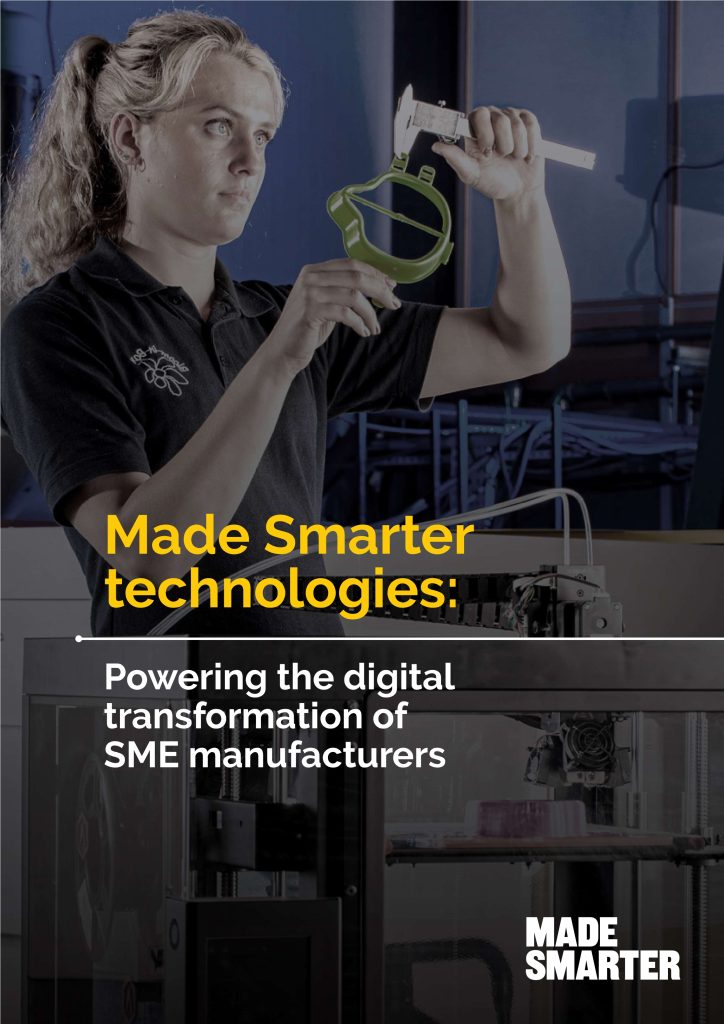Join the Expert Committee for the 2024 3D Printing Industry Awards to help select the winners!
PrintCity has partnered with Made Smarter to release a new white paper to simplify technology for small and medium-sized enterprise (SME) manufacturers.
Titled “Made Smarter Technologies: powering the digital transformation of SME manufacturers,” the document serves as a practical guide for manufacturers interested in adopting various digital technologies. Focusing on informing and inspiring manufacturers, this white paper delves into technologies including software, industrial IoT, automation, robotics, 3D printing, cybersecurity, AI, and digital twins. It explores the benefits of these technologies while also offering practical guidance on implementing them within manufacturing operations.
“This new white paper brings all those elements together into a useful and simple to understand guide which business leaders and digital champions can download and share with their teams. We hope it is the starting point for further conversations with the Made Smarter team,” said Donna Edwards, Director of Made Smarter’s North West Adoption Programme.

Equipping SMEs with a competitive edge
PrintCity has assisted more than 200 SMEs in the development of new products, goods, and services for the past six years. Professor Carl Diver, the Director of PrintCity, stressed the significance of streamlining 3D printing to enhance productivity and foster growth within enterprises.
Launched in 2019, Made Smarter has helped 300 manufacturers invest £22.5 million in various digital technologies. This resulted in the creation of 1,600 new jobs and the upskilling of 2,850 existing positions. The program’s impact extends beyond job creation, with a total economic contribution of £242 million. This highlights the real-world benefits of adopting new technologies for small and medium-sized businesses.
“Over the last five years technology has shown its true colours in the form of growth, investment, employment, productivity, and a competitive advantage. The race is now on to fully capitalise on the opportunities that exist, as well as those on the horizon. Business leaders therefore need the skills, knowledge, and experience to respond to this rapid change,” added Edwards.
Made Smarter provides training programs for SMEs to adopt new technologies. These programs include the Fast Track Digital Workforce Fund and Leadership initiatives. Edwards pointed out that the program helps SME manufacturers use digital tools effectively to remain competitive in a fast-changing environment.
The white paper includes contributions from leading manufacturing research institutions, such as the Manufacturing Technology Centre (MTC), the Advanced Manufacturing Research Centre (AMRC) North West, and the Hartree Centre. These institutions play a vital role in demonstrating emerging technologies and facilitating knowledge transfer within the manufacturing sector.

SMEs benefit from additive manufacturing
Unlike traditional methods, additive manufacturing empowers SME manufacturers by enabling them to produce low-volume parts and prototypes on-demand, leading to faster design cycles, reduced costs, and increased customization for niche markets. This technology offers a competitive advantage for SMEs competing with larger companies in a fast-paced environment. In many ways, companies have been taking steps to streamline 3D printing for SME manufacturers.
Last year, ASTRO America partnered with aerospace giants like Pratt & Whitney, Honeywell, and GE, to simplify the adoption of AM for small businesses. Working together, the companies aimed to create standardized qualification requirements, eliminating the current burden of meeting various protocols for different manufacturers. Backed by the Office of the Under Secretary of Defense, Research and Engineering (OUSD(R&E), and America Makes, this initiative sought to streamline the onboarding process for small 3D printing vendors in the aerospace industry.
What 3D printing trends do the industry leaders anticipate this year?
What does the Future of 3D printing hold for the next 10 years?
To stay up to date with the latest 3D printing news, don’t forget to subscribe to the 3D Printing Industry newsletter or follow us on Twitter, or like our page on Facebook.
While you’re here, why not subscribe to our Youtube channel? Featuring discussion, debriefs, video shorts, and webinar replays.
Featured image shows a sample of projects undertaken with PrintCity. Photo by Michael Petch.


